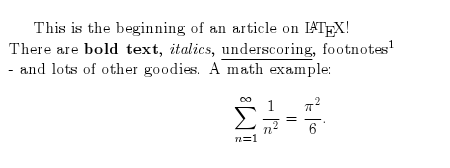LaTeX
LaTeX is a markup language for generating print-quality typesetting.
A file with formatting tags is compiled to create a high-quality print-ready graphical file, observing the rules of style defined by typesetting professionals.
It is mostly used in academic circles, primarily in the natural sciences, for creating material for scientific publications. LaTeX is particularly well-equipped for displaying formulas and diagrams.
While critics claim that using a markup language structure is dated compared to using WYSIWYG word processors, LaTeX still plays an important part in the industry.
The LaTeX system is continually under development. It is extensible by packages, and packages can found at (and submitted to) the Comprehensive TeX Archive Network[1].
How it works
A LaTeX document structure is split in two: There is a preamble, which indicates some basic, overall features of the document, and there is the main document with the relevant markup for formatting.
The document is initially created as a flat file, meaning that one can use any non-formatting editor of choice. Editors like Notepad++[2] and TeXmaker[3] will syntax color the LaTeX code, making it more intuitive to write.
As the code is a flat file, the output file will be small compared to files from many standard word processing applications.
Code example
\documentclass[12pt,a4paper,notitlepage]{article}
\usepackage[utf8x]{inputenc}
\usepackage{ucs}
\usepackage{amsmath}
\usepackage{amsfonts}
\author{Morten Juhl Johansen}
\title{LaTeX article}
\begin{document}
This is the beginning of an article on \LaTeX!\\
There are \textbf{bold text}, \textit{italics}, \underline{underscoring}, footnotes\footnote{this is a footnote}\\
- and lots of other goodies. A math example:
\begin{equation*}
\sum_{n=1}^\infty
\frac{1}{n^2}= \frac{\pi^2}{6}.
\end{equation*}
\end{document}
Literature
- Kopka, Helmut; Daly, Patrick W.: Guide to LaTeX. 4th edition. Addison-Wesley Professional, 2003. ISBN 0-321-17385-6.
- Lamport, Leslie: LaTeX: A document preparation system: User's guide and reference. 2nd edition, Reading, Mass. Addison-Wesley Professional, 1994. ISBN 0-201-52983-1.
